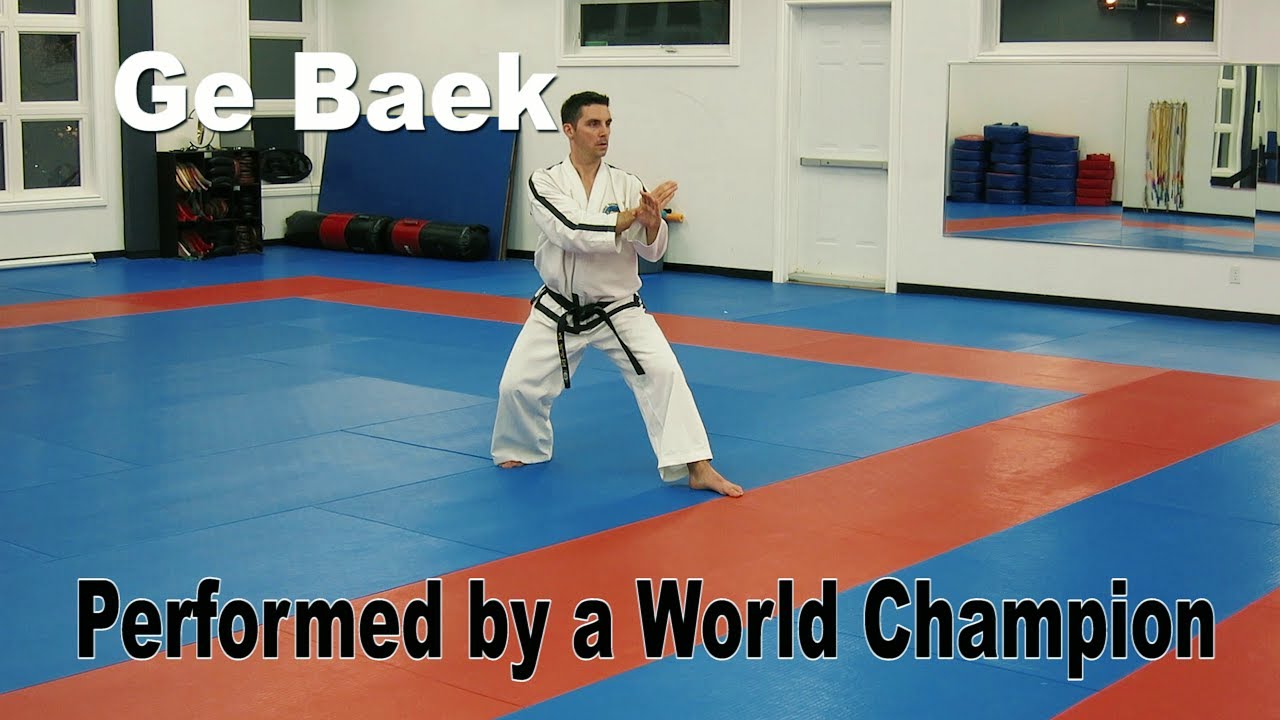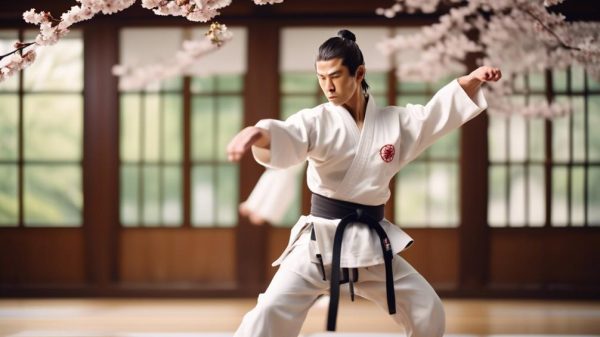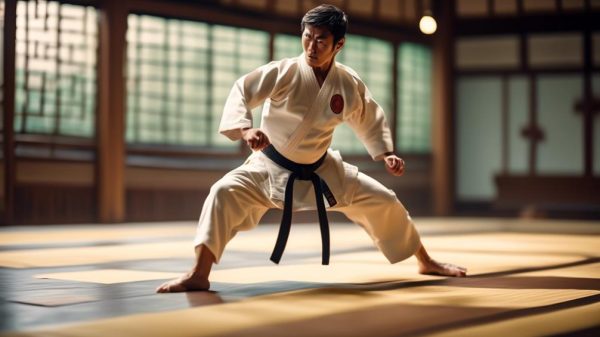Gae-Baek is an advanced Taekwondo pattern with over 70 sequenced motions. The form was created to honor a heroic Korean general skilled at martial arts.
Practicing the elaborate Gae-Baek techniques and stances boosts mental and physical control while telling a story of courage. Students embody the noble general’s legacy.
Flowing rapidly between blocks, strikes, kicks and strides in shifting directions challenges balance, reactions and endurance. Partner visualizations bring applications alive.
Students devotedly ingrain the general’s valiant fighting spirit along with precision, power and speed. Incremental Gae-Baek repetitions advance all-around abilities reflecting Taekwondo ideals.
Attention to detail in hand positions unify upper and lower body movements. Patience plus perseverance allows mastery to emerge and become second nature.
Key Takeaways
- Gae-Baek honors a famous 16th century Korean Baekje dynasty general, aiming to absorb the commander’s heroic spirit.
- Mastering the intricate kicking, punching, and blocking combinations boosts skillfulness in body dynamics and all-directional response capabilities.
- The shifting stances,multi-angle steps,and quick transitions strain dynamic balance, leg muscle strength/control and mental focus.
- Varied hand positioning trains dexterous isolations while synchronized footwork and arm motions build whole body unity and speed.
- Repeating Gae-Baek techniques ingrains reflexes, breathing control, and powerful hip torque generation through drill refinement and rhythm.
- Visualizing defending against assaults from all angles fosters battle awareness and courage while flowing smoothly between offensive and defensive motions.
- Progress requires patience as complexity demands incremental mastery – making moves become natural reactions without thought as the mind leads the body.
The integrated lessons transfer General Gae-Baek’s proficiency into students by embedding the form’s study.
History of Form Gae Baek
The history of Form Gae Baek is a fascinating journey that explores its origins, evolution, and significance within the tapestry of Taekwondo.
Taekwondo is a martial art that embodies discipline and perseverance. Form Gae Baek holds a special place within Taekwondo as it represents the achievement of the esteemed rank of 1st Degree Senior black belt.
This form, rooted in the legacy of General Choi Hong Hi, the founder of ITF Taekwondo, serves as a bridge between the ancient principles and modern techniques of Taekwondo. The history of Form Gae Baek reflects the adaptability and resilience of Taekwondo as it has evolved over time.
Understanding the historical context of this form not only enhances your practice but also deepens your connection to the legacy of Taekwondo.
Key Movements and Techniques
Prepare yourself to explore the fundamental movements and techniques of Taekwondo Form Gae-Baek.
Visualize the precision and power behind each strike and block.
Recognize the importance of maintaining proper stances and footwork as you embark on your martial arts journey.
Embody the philosophy that every movement brings you closer to mastering this form, and let the fluidity of your techniques guide you towards excellence.
Striking and Blocking
Master the fundamental techniques of striking and blocking in Taekwondo Form Gae-Baek and embody the spirit of this martial art.
Each strike and block is a testament to your dedication and discipline. Precision, speed, and power are essential elements of Gae-Baek.
Your offensive and defensive techniques should seamlessly flow within the rhythmic pattern of this form. Be mindful of your stances and body posture, as they serve as the foundation of your mastery.
Regular practice is key to becoming proficient in this form. Seek guidance from your instructor to refine your movements and transitions. Take advantage of available resources such as the official curriculum, workshops, and seminars.
Remember that Taekwondo Form Gae-Baek is unique, and your commitment to mastering its distinct movements will set you apart.
Stances and Footwork
To excel in the Taekwondo Form Gae-Baek, it’s crucial to master the key movements and techniques of stances and footwork. These elements are essential for embodying the precision and power of this martial art.
The foundation of Taekwondo lies in the ability to transition seamlessly between different stances and execute precise footwork.
By emphasizing the importance of maintaining proper stances and body posture, practitioners can lay the groundwork for executing powerful and effective techniques.
Mastery of stances and footwork in Gae-Baek is crucial for showcasing proficiency in Taekwondo America, as it reflects the practitioner’s ability to harmonize physical movements with mental focus.
Seek guidance from experienced instructors and gradually increase speed and intensity to refine your stances and footwork, thereby embodying the essence of Taekwondo America.
Stances:
- Forward Stance: This stance is used for stability and power, making it fundamental for strong strikes.
- Horse Stance: The horse stance provides balance and strength, serving as the foundation for many techniques.
- Walking Stance: The walking stance enables mobility and quick transitions, which are essential for fluid movements.
Gae Baek Training Tips
Regular practice is essential for mastering Gae Baek in Taekwondo. To excel in this form, focus on each movement, emphasizing precision and fluidity. Pay attention to details like foot positioning, strike angles, and body coordination during transitions.
Use resources like Taekwondo America’s official curriculum, online videos, and seminars to deepen your knowledge. Seek guidance from experienced instructors to refine your techniques and embody the principles of Gae Baek.
As you progress, increase the speed and intensity of your practice sessions to improve agility and power.
Remember that mastering Gae Baek requires dedication, patience, and a relentless pursuit of perfection.
Embrace challenges, persevere through setbacks, and let the spirit of Taekwondo guide you towards excellence in Gae Baek.
Understanding the Symbolism
As you delve into the deeper meaning behind the movements of Gae-Baek, you’ll uncover a fascinating history of discipline and military strength.
This form is intricately connected to the Baekje dynasty and its martial traditions, offering valuable insights into ancient Korean warfare.
Symbolic Movements
The movements in Taekwondo Form Gae-Baek symbolize both defense and attack techniques, representing the philosophy of martial arts.
To fully understand this form, it’s important to grasp the symbolism behind each movement.
The symbolism in Taekwondo America Form Gae-Baek highlights not only physical abilities but also the mental and spiritual aspects of martial arts.
The following table illustrates the symbolic movements in Taekwondo America Form Gae-Baek:
- High block: Represents defense
- Front kick: Signifies attack
- Low block: Represents grounding and stability
- Palm hooking block: Symbolizes redirecting energy
By practicing and embodying these symbolic movements, you won’t only develop physical strength and agility but also cultivate discipline and resilience.
Taekwondo forms like Gae-Baek represent big ideas along with the cool techniques. The general it is named after stood for courage that future students must show too.
Picturing the deeper meaning of the flowing steps, kicks, and punches helps genuine focus and mastery emerge rather than just following motions.
Devoted practice of Gae-Baek allows living the martial arts in how someone thinks and acts – passing principles on. Wisdom gets preserved through discipline and patience for positive influence.
Historical Significance
Recognize the historical significance of Gae-Baek as a reflection of General Gae-Baek’s unwavering military discipline and its enduring impact on the philosophy of martial arts.
This form embodies discipline and precision, mirroring the strict military training of General Gae-Baek.
When practicing the 44 movements, you aren’t simply learning a sequence, but delving into the rich history of the Baekje Dynasty and paying tribute to the legacy of General Gae-Baek.
Each stance, block, and strike symbolizes the resilience and strength of the Baekje Dynasty.
By mastering this form, you not only refine your Taekwondo skills, but also honor the historical significance of General Gae-Baek and the martial traditions that have shaped Taekwondo America.
It’s through understanding these roots that you truly embody the spirit of Taekwondo.
Gae Baek and Belt Ranks
As you progress through the belt ranks in Taekwondo, each new rank becomes a testament to your dedication, discipline, and continuous growth.
Gae Baek is a 1st Degree Senior black belt form in Taekwondo America that holds deep significance in the journey through the belt ranks.
It represents the culmination of foundational skills, a commitment that never wavers, and the readiness to take on more advanced training and understanding.
As you move up the ranks, Gae Baek becomes a pivotal milestone that requires a higher level of expertise in Taekwondo techniques and principles.
Mastering this form not only demonstrates your proficiency but also shows that you’re prepared for greater challenges. It focuses on refining kicks, strikes, and blocks, highlighting the importance of precision, speed, power, and flowing movements.
Moreover, Gae Baek isn’t just a form to be learned, but a form to be mastered. It serves as a vital bridge to higher belt levels, representing your progress and skill level in Taekwondo.
Therefore, as you strive for each new belt rank, approach the teachings of Gae Baek with enthusiasm and determination, as it’s through this form that your journey towards mastery truly unfolds.
Common Mistakes to Avoid
Avoiding common mistakes in mastering Gae-Baek requires unwavering precision, speed, and dedicated practice.
To truly excel in this pivotal form, it’s crucial to steer clear of common errors that might impede your progress. Here are some key points to keep in mind:
- Focus on Precise Movements:
Execute each movement with accuracy and precision to showcase the true essence of Gae-Baek. Pay attention to the details of every kick, strike, and block, ensuring that your technique is precise and effective.
- Emphasize Speed and Power:
Speed and power are fundamental in Taekwondo. Each movement should reflect the explosive nature of ITF Taekwondo. Strive to infuse every technique with the necessary power to make a lasting impact.
Gae Baek in Competition
To showcase your mastery of Gae-Baek in competition, it’s crucial to embody precision, speed, and power. Competing in Gae Baek allows you to demonstrate your proficiency in fundamental techniques such as kicks, strikes, and blocks.
It’s not just about executing the movements; it’s about performing them with precision, speed, and power while maintaining proper stances and body posture.
Your performance in competition reflects the culmination of your training and discipline.
Achieving mastery in Gae Baek for competition requires consistent and focused practice.
Lean on your teacher when having trouble perfecting new skills or smoothing out motions. Asking questions plus studying is key.
Whether practicing steps, hand strikes, or deflections, pour your focus into every small detail. Move in a manner respecting the art and its teachings.
Demonstrate your devotion to betterment in each session through the control, effort, and attentiveness shown. Progress follows discipline.
Let your commitment glow through raised standards for your techniques instead of worrying what anybody else thinks. Pursue excellence on your path.
Taekwondo attitudes, plus mastering skills, matter more than winning trophies. Forms like Gae Baek teach focus and courage beyond showing off.
If competition routines flow with technical precision but also portray the deeper meaning behind motions, judging ranks less over time.
Work diligently to mirror Gae Baek general’s valor in your face and moves. Move through stances committed to your growth rather than what places.
Let displays show your increasing discipline without arrogance. True progress satisfies internally, urges consistent self-betterment, and spreads wisdom.
Gae Baek Resources and References
Immerse yourself in the wide range of resources and references provided by Taekwondo to enhance your understanding and proficiency in Gae Baek. Taekwondo offers essential tools to support your journey towards mastering Gae Baek, including:
- Official Curriculum: Taekwondo America’s meticulously designed curriculum serves as a comprehensive guide, leading you through the intricate techniques and philosophies of Gae Baek. This structured approach will help you gain a thorough understanding of this form.
- Online Videos and Tutorials: Access a variety of online videos and tutorials endorsed by Taekwondo America. These visual aids are invaluable references for refining your Gae Baek techniques and improving your overall performance.
Additionally, Taekwondo America provides workshops, seminars, and collaborative opportunities for practitioners to engage with one another. These interactive platforms offer insights, personalized guidance, and the chance to refine your skills.
Frequently Asked Questions
How Do You Memorize Taekwondo Forms?
To memorize Taekwondo forms, you can use memory techniques. Start by breaking down the form into smaller sections and then visualize each section in your mind. Practice these sections repeatedly until you can perform them without hesitation. Seeking guidance from a knowledgeable instructor can also provide valuable feedback to help you improve. With dedication and focus, you can achieve mastery of the form.
What Is the Form of Taekwondo?
To understand the essence of Taekwondo, it is important to focus on mastering the fundamental principles of form. Emphasize precision, speed, and power in your movements. Seek guidance from your instructor and fellow practitioners to continually improve. Consistent training and gradually increasing intensity will lead you towards mastery in Taekwondo.
What Are the Black Belt Forms?
Mastering black belt forms is essential for demonstrating your expertise and proficiency in Taekwondo. Regular practice helps refine your form techniques, instilling discipline, focus, and confidence. It symbolizes your unwavering dedication and journey towards mastery.
How Many Types of Poomsae Are There in Taekwondo?
Perfect your poomsae techniques to become a master of Taekwondo. Poomsae, also known as forms, differ between ITF and WTF styles of Taekwondo. These forms focus on precise movements, stances, and techniques, showcasing the skill, discipline, and understanding of martial arts of the practitioner.









